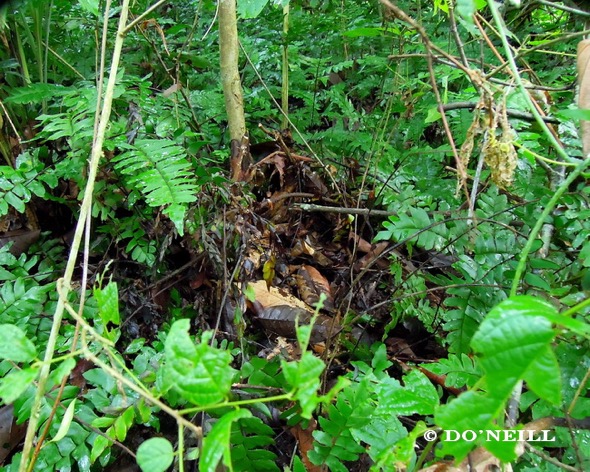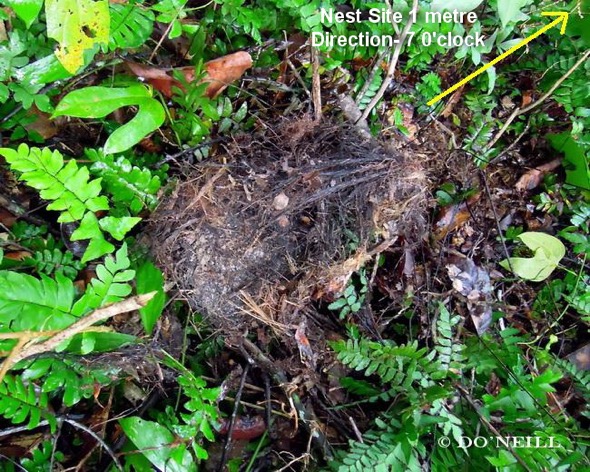Part 1 of the series can be found HERE, part 2 HERE, part 3 HERE and part 4 HERE.
“18th July added another new milestone in Blue-winged Pitta (Pitta moluccensis) study. After ten years of monitoring, I finally caught up with a rare opportunity to view Blue-winged Pitta fledglings greeted a new dawn (below).

“This monitoring series is probably the first, detailed documentation of successful nesting of Blue-winged Pitta for State of Penang, Peninsular Malaysia.
“By lunch time, three pitta fledglings were accounted for. Having secured my observations in photo print, I felt the urge to leave the site promptly. I have not forgotten those security dogs…
“I planned a return visit next day hopeful to observe chick feeding behaviours and inspection of the vacated nest.
“19th July- I returned to my usual observation post, stood at ridge boundary of orchard and scanned for pitta activity. I saw none.
“Rather disappointed this window period of post fledging was so short and was not in my favour to observe more, it was however not all in vain.
“On my way out, a rather spooky, secondary forest of mixed and thick undergrowth- opposite the orchard, an adult Blue-winged Pitta was spotted foraging. I recognised the bird to be Hercules. He, having spotted me and got found out, hopped rapidly away, gave an alarm call and flew about 3 metres up tree.
“My strong suspicion had it that the parents had moved their chicks to a holding area, like a crèche to nurture their young. I scanned with my binoculars but in vain to spot any of them as undergrowths were too dense. Hercules and Medusa had hidden their investments well.
“On same day, I caught up with orchard care taker and requested further two more days to complete field observation. He planned to clear orchard grounds and reinforced its boundary for fruit season had just begun.
“He was concerned for my own safety. In case any unsavoury incident did occur, those un-licensed dogs had to be put down.
“The care taker-a non bird watcher mentioned the evening before; one of the dogs broke loose its chain. Perhaps… it was a hint to discourage me. He was reassured, all field observations done would be at my own risk and orchard owners need not be inconvenient.
“20th July would be the last day to bring field observation to a close.
“It would be the first time I got close to inspecting the vacated nest.

“Armed with a ‘Pokostick’ and measuring tape, I pussy footed along the edge of orchard. I came to a tree sapling (above) – the focus point for this anxious looking, parenting pair – Hercules and Medusa (below).

“I stood and stared at the foot of tree sapling and what I found?
“A hollow shaped out by withered foliages turned brown-the site of Pitta’s nest… but where was the nest (below)?

“A metre downward, gentle slope at 7 O’clock from foot of tree sapling, Pitta’s nest was found in disarray (below).

“It was too tattered for measurements to be taken. The greyish area would have been the nest chamber. Materials used for the nest appeared to be made of twigs, lots of fine bamboo leaves and roots.
“The difference between this nest and previous nest encounters was; this particular nest was very light and loosely woven. It was straw light that when I picked it up with ‘Pokostick’, the nest just fell apart into two sections (below).

“I stood quite stunned. The orchard was silent like a graveyard. The Pittas that I had became familiar with, had abandoned the orchard and took their chicks with them.
“Where I stood, was within view by one of the security dogs. My luck held well, for canine was having his morning ‘lay in.’
“As heavy as my heart was to my feet, I threw caution to the wind as I walked out of fruit orchard. Sound of heavy footsteps and rustled vegetation alerted dosing dogs in chains and sent them barking mad. I was ready for action with my third foot!
“I was about to get into my vehicle to leave. A single Blue-winged Pitta’s call rang out from within the same ‘crèche area.
“It was a confirmation call, suggesting pitta family was still around on 2nd post fledging day. I decided it was best to respectively leave them alone.
“It was also a ‘Goodbye’ call from Hercules as no more calls were heard 3rd post-fledging day onwards and forest was deserted.
“Hercules, Medusa and chicks- Doe, Ray and Me had moved on….
“Do parenting BW Pittas force fledge their chicks by tearing up their nest? I do not have any photographs to show cause of such claims. Neither have I ever witnessed such an interesting phenomenon and therefore, cannot confirm such suggestion mentioned in a website article.
“If such suspicion holds water, readers will have to visualise a Pitta pair do an ‘Open Sesame’- tearing off dome of nest to expose chicks; and for whatever reason unknown, dragged the ripped nest a metre away.
“How did tattered nest then turn up a metre away from original nesting spot? A mystery to solve…….?
“Do join me to read final Part 6- ‘Constructive analysis of successful BW Pitta fledglings’ coming up soon…”
Avian Writer Daisy O’Neill
Penang, Malaysia
23rd September 2016
Copyright article and all copy images – Courtesy of Daisy O’Neill Bird Conservation Fund









One Response
Thank you for this wonderful piece!
And … brave you! Do not like ‘mad’ dogs!